Preoperative Planning for Reverse Shoulder Arthroplasty: Does the Clinical Range of Motion Match the Planned 3D Humeral Displacement?
Abstract
1. Introduction
2. Materials and Methods
2.1. Materials
2.1.1. Patients
2.1.2. RSA Implants
2.1.3. Software
2.2. Methods
- The extraction of the 3D geometry of the humerus and scapula from the preoperative CT scan;
- The manual registration of the preoperative 3D geometry of the humerus and scapula, with RSA implants from the postoperative CT scan, using the PTC Creo® software;
- The creation of planning files integrating the readjusted bone and implant geometries in the BluePrint® software to measure the postoperative ACP corresponding to the RSA implant configuration specific to each patient.
3. Results
3.1. Descriptive Data
3.2. Analytical Data
- The first observation was the gains in flexion. Flexion tended to decrease with humeral distalization (or lowering). There was a threshold around 38 mm, which was associated with the worse RoM values; shoulder flexion was better when the resulting humerus position was less distal (R2 = 0.29, p = 0.07). This “threshold” effect of humeral distalization was also observed for other shoulder motions, but the correlation was not as strong. The gains in ER1, ABD, ER2, and IR1 seemed better when the humerus was lowered less than 35 or 38 mm, depending on the patient.
- The second observation was the gains in ER1, which tended to improve with humeral lateralization (R2 = 0.29, p = 0.07).
4. Discussion
5. Conclusions
Author Contributions
Funding
Institutional Review Board Statement
Informed Consent Statement
Data Availability Statement
Acknowledgments
Conflicts of Interest
References
- Grammont, P.M.; Baulot, E. Delta shoulder prosthesis for rotator cuff rupture. Orthopedics 1993, 16, 65–68. [Google Scholar] [CrossRef]
- Drake, G.N.; O’Connor, D.P.; Edwards, T.B. Indications for reverse total shoulder arthroplasty in rotator cuff disease. Clin. Orthop. Relat. Res. 2010, 468, 1526–1533. [Google Scholar] [CrossRef]
- Boileau, P.; Watkinson, D.; Hatzidakis, A.M.; Hovorka, I. Neer Award 2005: The Grammont reverse shoulder prosthesis: Results in cuff tear arthritis, fracture sequelae, and revision arthroplasty. J. Shoulder Elb. Surg. 2006, 15, 527–540. [Google Scholar] [CrossRef]
- Petrillo, S.; Longo, U.G.; Papalia, R.; Denaro, V. Reverse shoulder arthroplasty for massive irreparable rotator cuff tears and cuff tear arthropathy: A systematic review. Musculoskelet. Surg. 2017, 101, 105–112. [Google Scholar] [CrossRef]
- Bufquin, T.; Hersan, A.; Hubert, L.; Massin, P. Reverse shoulder arthroplasty for the treatment of three- and four-part fractures of the proximal humerus in the elderly: A prospective review of 43 cases with a short-term follow-up. J. Bone Jt. Surg. Br. 2007, 89, 516–520. [Google Scholar] [CrossRef] [PubMed]
- Wall, B.; Nové-Josserand, L.; O’Connor, D.P.; Edwards, T.B.; Walch, G. Reverse total shoulder arthroplasty: A review of results according to etiology. J. Bone Jt. Surg. Am. 2007, 89, 1476–1485. [Google Scholar]
- Holcomb, J.O.; Hebert, D.J.; Mighell, M.A.; Dunning, P.E.; Pupello, D.R.; Pliner, M.D.; Frankle, M. Reverse shoulder arthroplasty in patients with rheumatoid arthritis. J. Shoulder Elb. Surg. 2010, 19, 1076–1084. [Google Scholar] [CrossRef]
- Walker, M.; Willis, M.P.; Brooks, J.P.; Pupello, D.; Mulieri, P.J.; Frankle, M.A. The use of the reverse shoulder arthroplasty for treatment of failed total shoulder arthroplasty. J. Shoulder Elb. Surg. 2012, 21, 514–522. [Google Scholar] [CrossRef] [PubMed]
- Ryan, D. Indications for Reverse Shoulder Arthroplasty. In Shoulder Arthro-Plasty: The Shoulder Club Guide; Huri, G., Familiari, F., Moon, Y.L., Doral, M.N., Marcheggiani Muccioli, G.M., Eds.; Springer International Publishing: Cham, Switzerland, 2021; pp. 97–102. [Google Scholar]
- Muh, S.J.; Streit, J.J.; Wanner, J.P.; Lenarz, C.J.; Shishani, Y.; Rowland, D.Y.; Riley, C.; Nowinski, R.J.; Edwards, T.B.; Gobezie, R. Early follow-up of reverse total shoulder arthroplasty in patients sixty years of age or younger. J. Bone Jt. Surg. Am. 2013, 95, 1877–1883. [Google Scholar] [CrossRef] [PubMed]
- Samuelsen, B.T.; Wagner, E.R.; Houdek, M.T.; Elhassan, B.T.; Sánchez-Sotelo, J.; Cofield, R.; Sperling, J.W. Primary reverse shoulder arthroplasty in patients aged 65 years or younger. J. Shoulder Elb. Surg. 2017, 26, e13–e17. [Google Scholar] [CrossRef]
- Chelli, M.; Cunsolo, L.L.; Gauci, M.-O.; Gonzalez, J.-F.; Domos, P.; Bronsard, N.; Boileau, P. Reverse shoulder arthroplasty in patients aged 65 years or younger: A systematic review of the literature. JSES Open Access 2019, 3, 162–167. [Google Scholar] [CrossRef] [PubMed]
- Leathers, M.P.; Ialenti, M.N.; Feeley, B.T.; Zhang, A.L.; Ma, C.B. Do younger patients have better results after reverse total shoulder arthroplasty? J. Shoulder Elb. Surg. 2018, 27, S24–S28. [Google Scholar] [CrossRef] [PubMed]
- Australian Orthopaedic Association National Joint Replacement Registry. Hip, Knee & Shoulder Arthroplasty Annual Report 2019; AOA: Adelaide, Australia, 2019. [Google Scholar]
- Best, M.J.; Aziz, K.T.; Wilckens, J.H.; McFarland, E.G.; Srikumaran, U. Increasing incidence of primary reverse and anatomic total shoulder arthroplasty in the United States. J. Shoulder Elb. Surg. 2021, 30, 1159–1166. [Google Scholar] [CrossRef] [PubMed]
- Villatte, G.; Erivan, R.; Barth, J.; Bonnevialle, N.; Descamps, S.; Boisgard, S. Progression and projection for shoulder surgery in France, 2012–2070: Epidemiologic study with trend and projection analysis. Orthop. Traumatol. Surg. Res. 2020, 106, 1067–1077. [Google Scholar] [CrossRef] [PubMed]
- Baulot, E.; Sirveaux, F.; Boileau, P. Grammont’s idea: The story of paul grammont’s functional surgery concept and the devel-opment of the reverse principle. Clin. Orthop. Relat. Res. 2011, 469, 2425–2431. [Google Scholar] [CrossRef]
- Grammont, P.; Trouilloud, P.; Laffay, J.; Deries, X. Étude et réalisation d’une nouvelle prothèse d’épaule. Rhumatologie 1987, 39, 407–418. [Google Scholar]
- Berliner, J.; Regalado-Magdos, A.; Ma, C.; Feeley, B. Biomechanics of reverse total shoulder arthroplasty. J. Shoulder Elb. Surg. 2015, 24, 150–160. [Google Scholar] [CrossRef]
- Boileau, P.; Moineau, G.; Roussanne, Y.; O’Shea, K. Bony increased-offset reversed shoulder arthroplasty minimizing scapular impingement while maximizing glenoid fixation. Clin. Orthop. Relat. Res. 2011, 469, 2558–2567. [Google Scholar] [CrossRef]
- Lädermann, A.; Denard, P.J.; Boileau, P.; Farron, A.; Deransart, P.; Terrier, A.; Ston, J.; Walch, G. Effect of humeral stem design on humeral posi-tion and range of motion in reverse shoulder arthroplasty. Int. Orthop. 2015, 39, 2205–2213. [Google Scholar] [CrossRef]
- Lädermann, A.; Gueorguiev, B.; Charbonnier, C.; Stimec, B.V.; Fasel, J.H.; Zderic, I.; Hagen, J.; Walch, G. Scapular Notching on Kinematic Simulated Range of Motion After Reverse Shoulder Arthroplasty Is Not the Result of Impingement in Adduction. Medicine 2015, 94, e1615. [Google Scholar] [CrossRef]
- Sirveaux, F.; Favard, L.; Oudet, D.; Huquet, D.; Walch, G.; Molé, D. Grammont inverted total shoulder arthroplasty in the treatment of glenohumeral osteoarthritis with massive rupture of the cuff. Results of a multicentre study of 80 shoulders. J. Bone Jt. Surg. Br. 2004, 86, 388–395. [Google Scholar] [CrossRef] [PubMed]
- Katz, D.; Valenti, P.; Kany, J.; Elkholti, K.; Werthel, J. Does lateralisation of the centre of rotation in reverse shoulder arthroplasty avoid scapular notching? Clinical and radiological review of one hundred and forty cases with forty five months of follow-up. Int. Orthop. 2016, 40, 99–108. [Google Scholar] [CrossRef]
- Athwal, G.; MacDermid, J.; Reddy, K.; Marsh, J.; Faber, K.; Drosdowech, D. Does bony increased-offset reverse shoulder arthro-plasty decrease scapular notching? J. Shoulder Elb. Surg. 2015, 24, 468–473. [Google Scholar] [CrossRef] [PubMed]
- Lädermann, A.; Edwards, T.B.; Walch, G. Arm lengthening after reverse shoulder arthroplasty: A review. Int. Orthop. 2014, 38, 991–1000. [Google Scholar] [CrossRef]
- Lädermann, A.; Walch, G.; Lubbeke, A.; Drake, G.N.; Melis, B.; Bacle, G.; Collin, P.; Edwards, T.B.; Sirveaux, F. Influence of arm lengthening in reverse shoulder arthroplasty. J. Shoulder Elb. Surg. 2012, 21, 336–341. [Google Scholar] [CrossRef]
- Boutsiadis, A.; Lenoir, H.; Denard, P.J.; Panisset, J.-C.; Brossard, P.; Delsol, P.; Guichard, F.; Barth, J. The lateralization and distalization shoulder an-gles are important determinants of clinical outcomes in reverse shoulder arthroplasty. J. Shoulder Elb. Surg. 2018, 27, 1226–1234. [Google Scholar] [CrossRef]
- Berhouet, J.; Jacquot, A.; Walch, G.; Deransart, P.; Favard, L.; Gauci, M.-O. The Arm Change Position: Additional Information for Optimizing Range of Motion After Reverse Shoulder Arthroplasty. Orthop. Traumatol. Surg. Res. 2022, 108, 103246. [Google Scholar] [CrossRef]
- Kwon, Y.W.; Pinto, V.J.; Yoon, J.; Frankle, M.A.; Dunning, P.E.; Sheikhzadeh, A. Kinematic analysis of dynamic shoulder motion in patients with reverse total shoulder arthroplasty. J. Shoulder Elb. Surg. 2012, 21, 1184–1190. [Google Scholar] [CrossRef]
- Terrier, A.; Scheuber, P.; Pioletti, D.P.; Farron, A. Activities of daily living with reverse prostheses: Importance of scapular compensation for functional mobility of the shoulder. J. Shoulder Elb. Surg. 2013, 22, 948–953. [Google Scholar] [CrossRef]
- Constant, C.R.; Murley, A.H. A clinical method of functional assessment of the shoulder. Clin. Orthop. Relat. Res. 1987, 214, 160–164. [Google Scholar] [CrossRef]
- Werner, B.; Ascione, F.; Bugelli, G.; Walch, G. Does arm lengthening affect the functional outcome in onlay reverse shoulder arthroplasty? J. Shoulder Elb. Surg. 2017, 26, 2152–2157. [Google Scholar] [CrossRef] [PubMed]
- Jobin, C.M.; Brown, G.D.; Bahu, M.J.; Gardner, T.R.; Bigliani, L.U.; Levine, W.N.; Ahmad, C.S. Reverse total shoulder arthroplasty for cuff tear arthropathy: The clinical effect of deltoid lengthening and center of rotation medialization. J. Shoulder Elb. Surg. 2012, 21, 1269–1277. [Google Scholar] [CrossRef] [PubMed]
- Ferrier, A.; Blasco, L.; Marcoin, A.; De Boissieu, P.; Siboni, R.; Nérot, C.; Ohl, X. Geometric modification of the humeral position after total reverse shoulder arthroplasty: What is the optimal lowering of the humerus? J. Shoulder Elb. Surg. 2018, 27, 2207–2213. [Google Scholar] [CrossRef] [PubMed]
- Schwartz, D.; Cottrell, B.; Teusink, M.J.; Clark, R.E.; Downes, K.L.; Tannenbaum, R.S.; Frankle, M.A. Factors that predict postoperative motion in patients treated with reverse shoulder arthroplasty. J. Shoulder Elb. Surg. 2014, 23, 1289–1295. [Google Scholar] [CrossRef] [PubMed]




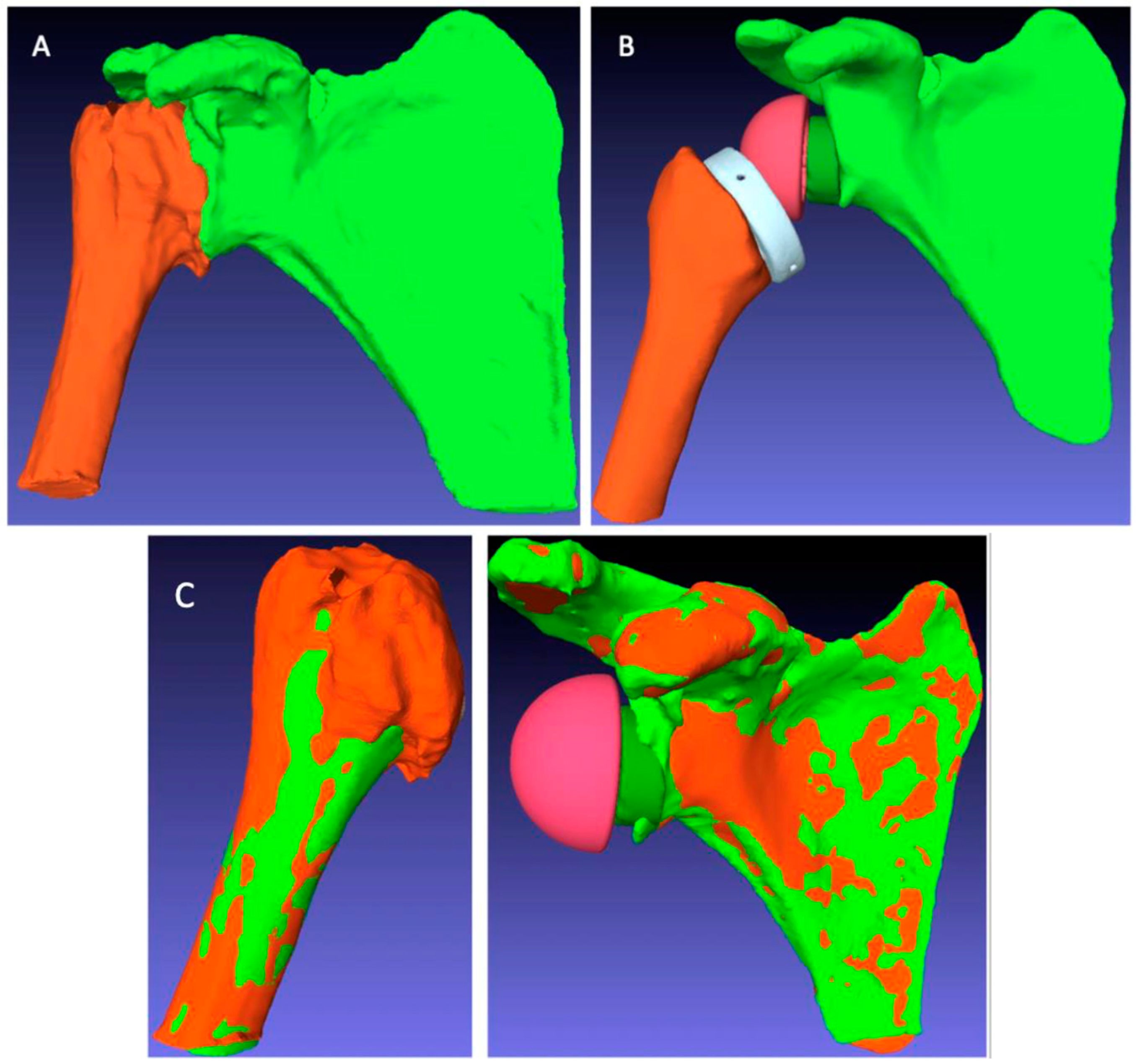
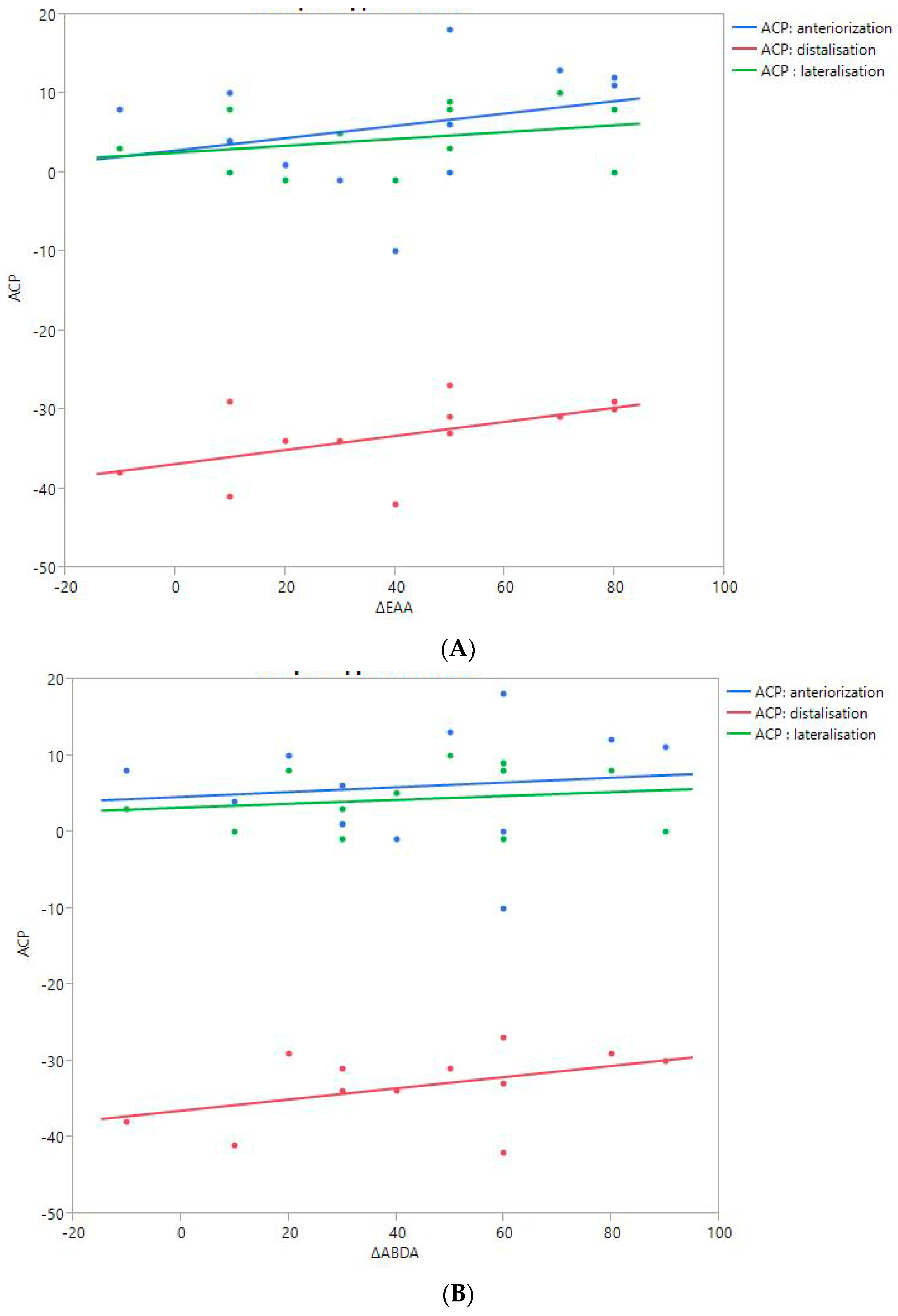
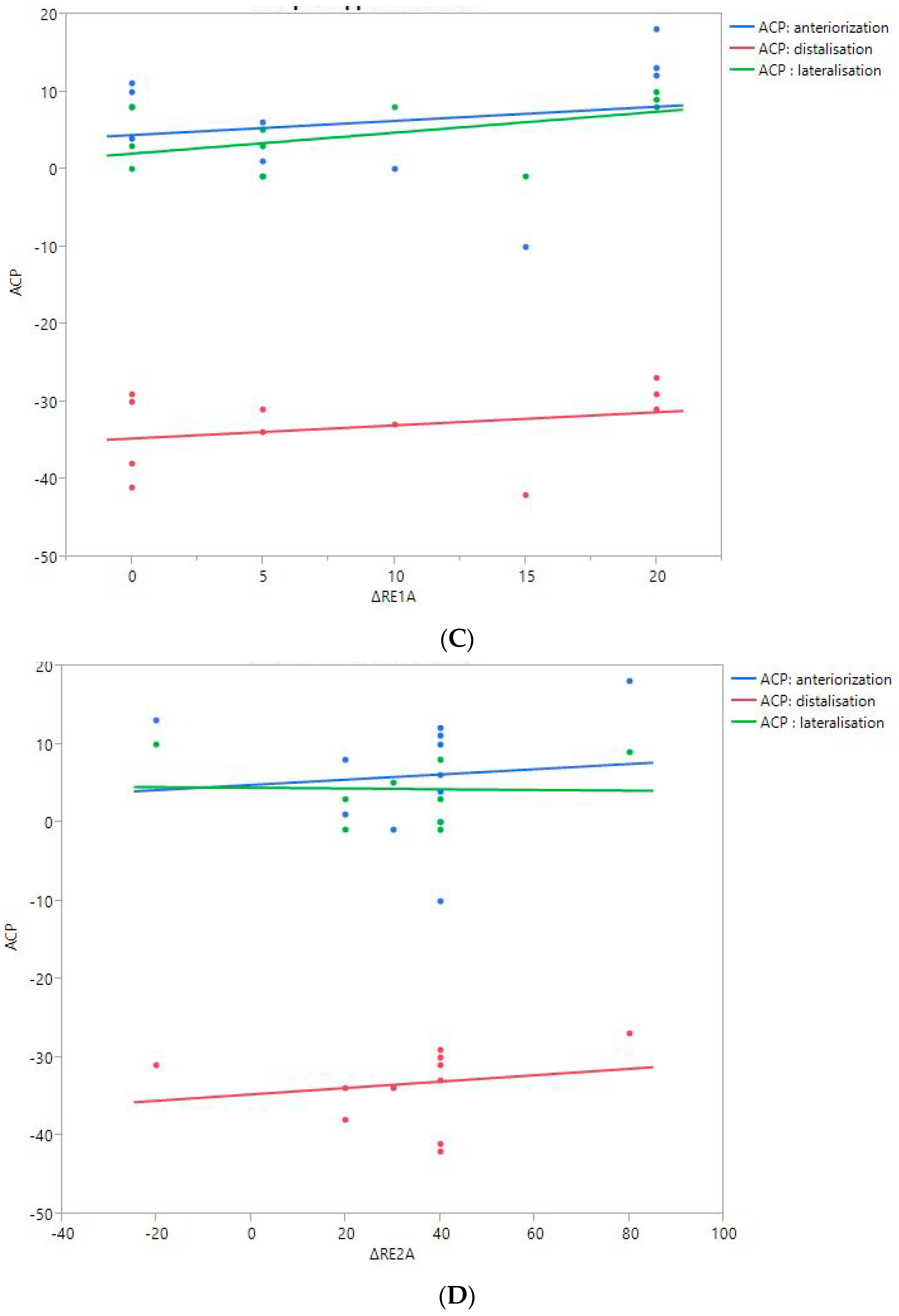
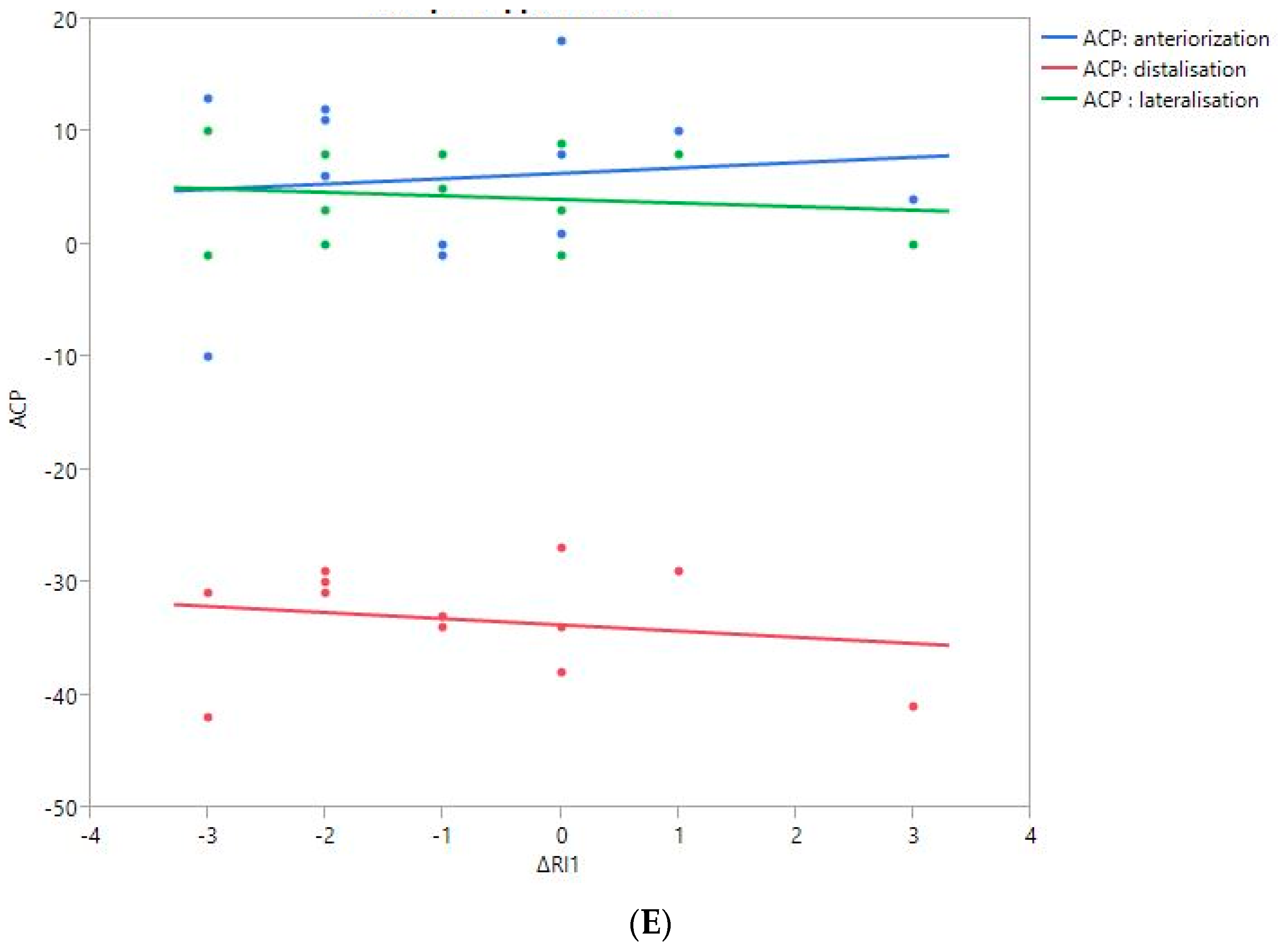
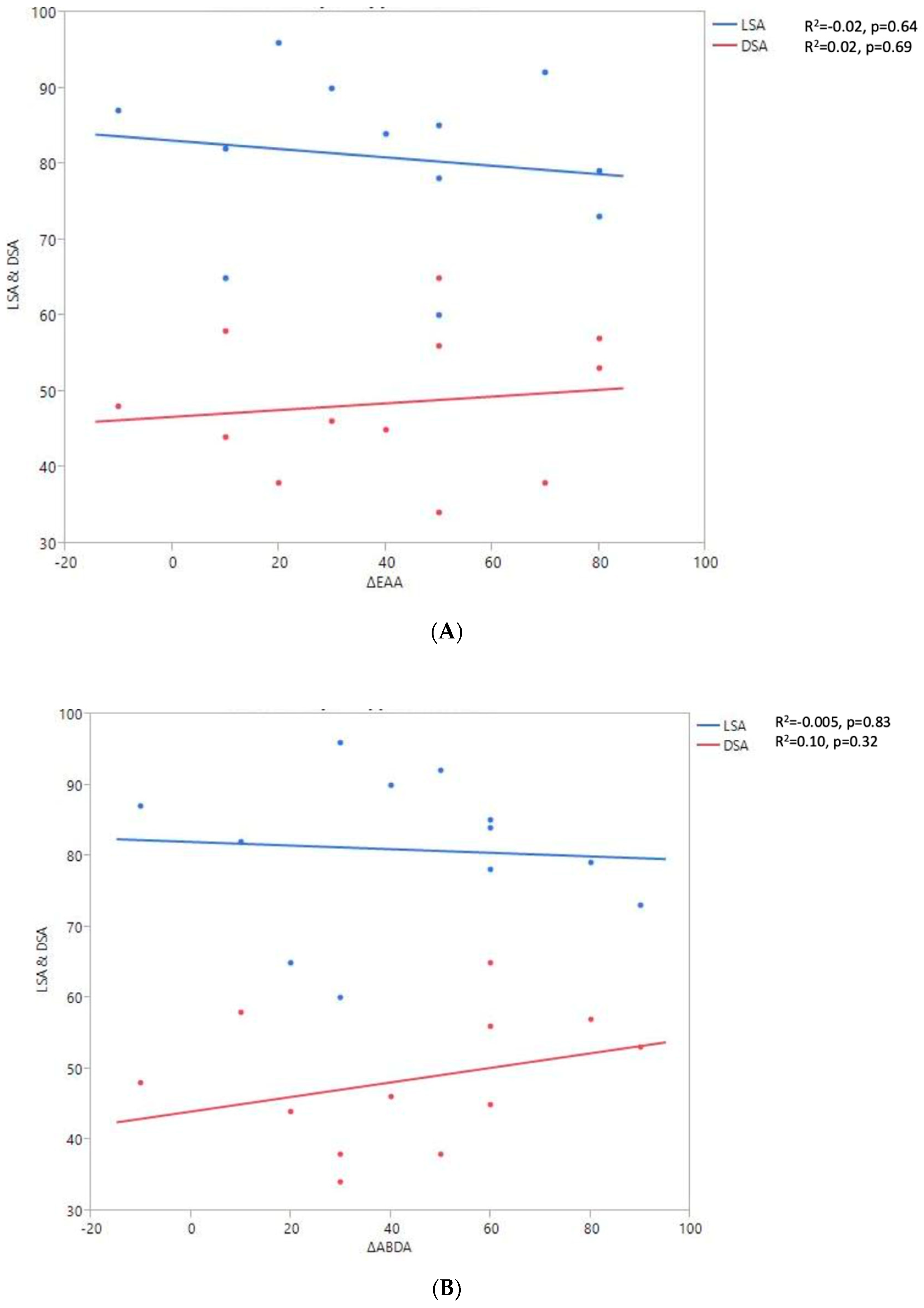



| Age | BMI | Flex | ABD | ER1 | ER2 | IR1 | Constant | CSA | LSA | DSA | ||
|---|---|---|---|---|---|---|---|---|---|---|---|---|
| OA group | Patient 1 | 81 | 32.1 | 30 | 20 | −10 | 0 | Thigh = 0 | 8 | 31 | 92 | 13 |
| Patient 2 | 77 | 31.6 | 80 | 70 | 5 | 20 | Thigh = 0 | 25 | 29 | 89 | 8 | |
| Patient 3 | 74 | 27.4 | 80 | 60 | −5 | 0 | Thigh = 0 | 21 | 42 | 87 | 14 | |
| Patient 4 | 79 | 34.4 | 90 | 80 | 0 | 0 | Thigh = 0 | 23 | 28 | 82 | −3 | |
| Patient 5 | 79 | 29.4 | 80 | 80 | −10 | 20 | Lumbosacral = 4 | 12 | 37 | 81 | 3 | |
| Patient 6 | 68 | 30.1 | 90 | 60 | −10 | 0 | Thigh = 0 | 21 | 39 | 100 | 12 | |
| Mean OA | 76 ± 5 (68–81) | 30.8 ± 2.4 (27.4–34.4) | 75 ± 23 (30–90) | 62 ± 22 (20–80) | −5 ± 6 (−10–5) | 7 ± 10 (0–20) | 1 ± 2 (0–4) | 18 ± 7 (8–25) | 34 ± 6 (28–42) | 89 ± 7 (81–100) | 8 ± 7 (−3–14) | |
| CTA group | Patient 7 | 72 | 27.1 | 120 | 110 | 10 | 50 | L3 = 6 | 32 | 39 | 125 | 6 |
| Patient 8 | 70 | 19.5 | 90 | 80 | 0 | 0 | T7 = 10 | 38 | 52 | 41 | 30 | |
| Patient 9 | 63 | 29.4 | 40 | 40 | 30 | 40 | Buttocks = 2 | 18 | 39 | 96 | 6 | |
| Patient 10 | 74 | 28.0 | 80 | 70 | 10 | 30 | Buttocks = 2 | 24 | 42 | 55 | 5 | |
| Patient 11 | 71 | 27.5 | 110 | 100 | 25 | 50 | T7 = 10 | 34 | 34 | 105 | 18 | |
| Patient 12 | 73 | 25.4 | 150 | 150 | 0 | 20 | T7 = 10 | 47 | 40 | 105 | 18 | |
| Mean CTA | 71 ± 4 (63–73) | 26.2 ± 3.5 (19.5–29.4) | 98 ± 38 (40–150) | 92 ± 38 (40–150) | 13 ± 13 (0–30) | 32 ± 19 (0–50) | 7 ± 4 (2–10) | 32 ± 10 (18–47) | 41 ± 6 (34–52) | 88 ± 33 (41–125) | 14 ± 10 (5–30) | |
| p | 0.04 | 0.02 | 0.22 | 0.12 | 0.01 | 0.02 | 0.006 | 0.002 | 0.08 | 0.96 | 0.25 | |
| Overall Mean | 73 ± 4 (63–81) | 28.5 ± 3 (19.5–34.4) | 87 ± 31 (30–150) | 77 ± 31 (20–150) | 4 ± 10 (−10–30) | 19 ± 16 (0–50) | 4 ± 4 (0–10) | 25 ± 9 (8–47) | 38 ± 6 (28–52) | 88 ± 24 (41–125) | 11 ± 9 (−3–30) |
| EA | ABD | RE1 | RE2 | RI1 | Constant | CSA | LSA | DSA | ACP Latéralisation | ACP Antériorisation | ACP Distalisation | ||
|---|---|---|---|---|---|---|---|---|---|---|---|---|---|
| OA group | Patient 1 | 80 | 80 | 0 | 40 | Buttocks = 2 | 32 | 28 | 78 | 65 | 8 | 0 | −33 |
| Patient 2 | 130 | 100 | 10 | 60 | Lumbosacral = 4 | 67 | 19 | 60 | 34 | 3 | 6 | −31 | |
| Patient 3 | 110 | 100 | 0 | 30 | Buttocks = 2 | 66 | 24 | 90 | 46 | 5 | −1 | −34 | |
| Patient 4 | 140 | 140 | 20 | 80 | Thigh = 0 | 67 | 24 | 85 | 56 | 9 | 18 | −27 | |
| Patient 5 | 160 | 160 | 10 | 60 | T12 = 8 | 79 | 23 | 79 | 57 | 8 | 12 | −29 | |
| Patient 6 | 130 | 120 | 5 | 40 | L3 = 6 | 73 | 30 | 84 | 45 | −1 | −10 | −42 | |
| Mean OA | 125 ± 27 (80–160) | 117 ± 29 (80–160) | 8 ± 8 (0–20) | 52 ± 18 (30–80) | 4 ± 3 (0–8) | 64 ± 17 (32–79) | 25 ± 4(19–30) | 79 ± 10 (60–90) | 51 ± 11 (34–65) | 5 ± 3 (−1–9) | 4 ± 8 (−10–18) | −33 ± 4 (−42– −27) | |
| CTA group | Patient 7 | 110 | 100 | 10 | 70 | L3 = 6 | 67 | 18 | 87 | 48 | 3 | 8 | −38 |
| Patient 8 | 100 | 100 | 0 | 40 | T12 = 8 | 60 | 34 | 65 | 44 | 8 | 10 | −29 | |
| Patient 9 | 110 | 90 | 50 | 20 | T12 = 8 | 55 | 47 | 92 | 38 | 10 | 13 | −31 | |
| Patient 10 | 160 | 160 | 10 | 70 | L3 = 6 | 79 | 30 | 73 | 53 | 0 | 11 | −30 | |
| Patient 11 | 130 | 130 | 30 | 70 | T7 = 10 | 66 | 22 | 96 | 38 | −1 | 1 | −34 | |
| Patient 12 | 160 | 160 | 0 | 60 | Lumbosacral = 4 | 72 | 34 | 82 | 58 | 0 | 4 | −41 | |
| Mean CTA | 128 ± 26 (100–160) | 123 ± 31 (90–160) | 17 ± 20 (0–50) | 55 ± 21 (20–70) | 7 ± 2 (4–10) | 69 ± 7 (60–79) | 31 ± 10 (18–47) | 83 ± 12 (65–96) | 47 ± 8 (38–58) | 3 ± 4 (−1–10) | 8 ± 4 (1–13) | −34 ± 4 (−41– −29) | |
| p | 0.83 | 0.71 | 0.31 | 0.77 | 0.05 | 0.57 | 0.20 | 0.63 | 0.49 | 0.53 | 0.96 | 0.21 | |
| Overall mean | 127 ± 27 (80–160) | 120 ± 30 (80–160) | 12 ± 15 (0–50) | 53 ± 20 (20–80) | 5 ± 3 (0–10) | 66 ± 13 (32–79) | 28 ± 8 (18–47) | 81 ± 11 (60–96) | 49 ± 10 (34–65) | 4 ± 4 (−1– 10) | 6 ± 6 (−10–18) | −33 ± 4 (−42– −27) |
| Δflex | ΔABD | ΔER1 | ΔER2 | ΔIR1 | ΔConstant | ACP lat | ACP ant | ACP dist | ||
|---|---|---|---|---|---|---|---|---|---|---|
| OA group | Patient 1 | 50 | 60 | 10 | 40 | 2 | 24 | 8 | 0 | −33 |
| Patient 2 | 50 | 30 | 5 | 40 | 4 | 42 | 3 | 6 | −31 | |
| Patient 3 | 30 | 40 | 5 | 30 | 2 | 45 | 5 | −1 | −34 | |
| Patient 4 | 50 | 60 | 20 | 80 | 0 | 44 | 9 | 18 | −27 | |
| Patient 5 | 80 | 80 | 20 | 40 | 4 | 67 | 8 | 12 | −29 | |
| Patient 6 | 40 | 60 | 15 | 40 | 6 | 52 | −1 | −10 | −42 | |
| Mean OA | 50 ± 16 (30–80) | 55 ± 18 (30–80) | 13 ± 7 (5–20) | 45 ± 18 (30–80) | 3 ± 2 (0–6) | 64 ± 17 (32–79) | 5 ± 3 (−1–9) | 4 ± 8 (−10–18) | −33 ± 4 (−42– −27) | |
| CTA group | Patient 7 | −10 | −10 | 0 | 20 | 0 | 35 | 3 | 8 | −38 |
| Patient 8 | 10 | 20 | 0 | 40 | −2 | 22 | 8 | 10 | −29 | |
| Patient 9 | 70 | 50 | 20 | −20 | 6 | 10 | 13 | −31 | ||
| Patient 10 | 80 | 90 | 0 | 40 | 4 | 55 | 0 | 11 | −30 | |
| Patient 11 | 20 | 30 | 5 | 20 | 10 | 32 | −1 | 1 | −34 | |
| Patient 12 | 10 | 10 | 0 | 40 | −6 | 25 | 0 | 4 | −41 | |
| Mean CTA | 30 ± 36 (−10–80) | 32 ± 35 (−10–90) | 4 ± 8 (0–20) | 23 ± 23 (−20–40) | 2 ± 6 (−6–10) | 69 ± 7 (60–79) | 3 ± 4 (−1–10) | 8 ± 4 (1–13) | −34 ± 4 (−41– −29) | |
| p | 0.25 | 0.17 | 0.08 | 0.10 | 0.70 | 0.17 | 0.53 | 0.96 | 0.21 | |
| Overall Mean | 40 ± 29 (−10–80) | 43 ± 29 (−10–90) | 8 ± 8 (0–20) | 34 ± 23 (−20–80) | 3 ± 4 (−6–10) | 40 ± 14 (22–55) | 4 ± 4 (−1– 10) | 6 ± 6 (−10–18) | −33 ± 4 (−42– −27) |
Disclaimer/Publisher’s Note: The statements, opinions and data contained in all publications are solely those of the individual author(s) and contributor(s) and not of MDPI and/or the editor(s). MDPI and/or the editor(s) disclaim responsibility for any injury to people or property resulting from any ideas, methods, instructions or products referred to in the content. |
© 2023 by the authors. Licensee MDPI, Basel, Switzerland. This article is an open access article distributed under the terms and conditions of the Creative Commons Attribution (CC BY) license (https://creativecommons.org/licenses/by/4.0/).
Share and Cite
Yoon, D.J.Y.; Odri, G.-A.; Favard, L.; Samargandi, R.; Berhouet, J. Preoperative Planning for Reverse Shoulder Arthroplasty: Does the Clinical Range of Motion Match the Planned 3D Humeral Displacement? J. Pers. Med. 2023, 13, 771. https://doi.org/10.3390/jpm13050771
Yoon DJY, Odri G-A, Favard L, Samargandi R, Berhouet J. Preoperative Planning for Reverse Shoulder Arthroplasty: Does the Clinical Range of Motion Match the Planned 3D Humeral Displacement? Journal of Personalized Medicine. 2023; 13(5):771. https://doi.org/10.3390/jpm13050771
Chicago/Turabian StyleYoon, Diane Ji Yun, Guillaume-Anthony Odri, Luc Favard, Ramy Samargandi, and Julien Berhouet. 2023. "Preoperative Planning for Reverse Shoulder Arthroplasty: Does the Clinical Range of Motion Match the Planned 3D Humeral Displacement?" Journal of Personalized Medicine 13, no. 5: 771. https://doi.org/10.3390/jpm13050771
APA StyleYoon, D. J. Y., Odri, G.-A., Favard, L., Samargandi, R., & Berhouet, J. (2023). Preoperative Planning for Reverse Shoulder Arthroplasty: Does the Clinical Range of Motion Match the Planned 3D Humeral Displacement? Journal of Personalized Medicine, 13(5), 771. https://doi.org/10.3390/jpm13050771







